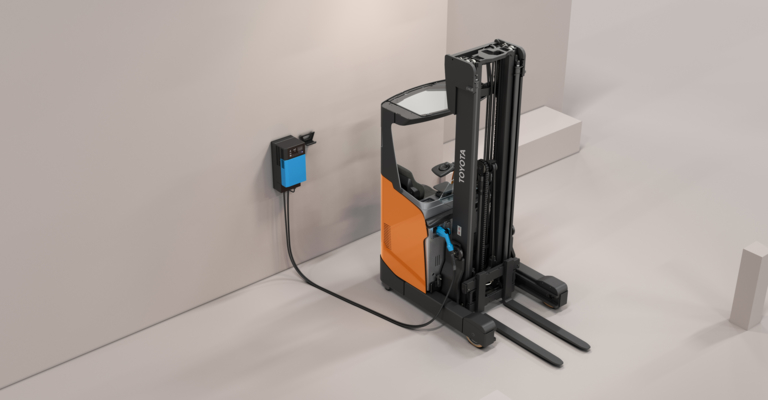Everything you need to know about lithium-ion batteries
Unravel the myths of Li-ion and fuel cell forklifts
Both lithium-ion and hydrogen energy sources help companies reach their sustainability goals, since they utilise less energy than traditional lead-acid batteries. Selecting the right energy option for your forklift fleet depends on your business priorities. But what do you know about these forklift energy sources?
Frequently asked questions about Lithium-ion forklifts
About li-ion and its benefits
What is lithium-ion?
Lithium-ion is a collective term for many different chemistries and technologies. It’s a type of battery, but compared to a traditional lead-acid battery, it has a much higher energy density and can therefore store and supply energy much faster.
Are there different types of lithium-ion battery?
The cells of the lithium-ion battery may consist of various cell chemistries. The most common in the truck and car industry are:
- LFP (lithium, iron, phosphate)
- NMC (nickel, manganese, cobalt)
- NCA (nickel, cobalt, aluminium)
Toyota uses NCA- or NMC cells in its lithium-ion batteries for forklifts, as these have a higher energy density and can contain more energy in the same volume.
Are lithium-ion batteries safe?
At Toyota, we use cylinder cells that do not touch each other. This makes them very safe to use. Safety and quality remain Toyota’s core values in everything that we do.
How do lithium-ion batteries work?
Lithium-ion is a collective term for many different chemistries and technologies. In general, most of the chemistries are based on creating energy through the movement of free ions between the anode and the cathode in a battery cell.
A lithium-ion battery combines several of these cells to form a module. Depending on the size of the battery, several modules may be connected in series, forming a battery system.
Each module has a battery management system (BMS), as does the entire battery system. The BMS monitors and controls factors such as battery charge and power consumption.
The BMS works in cooperation with the truck. If any of the cells in the battery module are damaged or are in danger of overheating, the power supply is switched off and the truck indicates a fault code.
What are the advantages of lithium-ion batteries?
Some of the advantages of lithium-ion technology include:
- More than three times the lifespan of lead-acid batteries
- 30% more energy-efficient batteries (compared to lead-acid)
- Lower energy consumption, enabling lower CO2 emissions
- Easy and fast charging: a 25V lithium-ion battery is fully charged in only 80 minutes (30 minutes for 50% battery capacity)
- Partial charging and ‘opportunity charging’ are possible without performance or lifespan penalties
- Power output is constantly as high as possible, regardless of the remaining capacity in the battery
- No battery topping or battery maintenance required
- Chargers can be installed anywhere, with no need for dedicated rooms
- Seven-year warranty
- Improved safety thanks to unique Toyota charging plug
- A single battery will serve the lifetime of a truck
- Works efficiently in chilled areas
- Heater option available for in-cold store charging and continuous performance throughout the shift
Which trucks are available with lithium-ion?
Lithium-ion batteries work for all types of machines and trucks. The capacity and size of the battery is adapted according to the amount of driving time and any shifts required.
How big are lithium-ion batteries?
A lithium-ion battery has up to 30% higher capacity than lead-acid batteries thanks to its high energy density, which means that with a lithium-ion battery it is possible to reduce Ah size compared to lead-acid. For example, 210 Ah lithium-ion corresponds to 300 Ah lead-acid. Lithium-ion batteries are smaller and weigh less than lead-acid batteries.
How long does a lithium-ion battery last?
A lithium-ion battery lasts up to 5,000 charges, while a lead-acid battery lasts about 1,500 times.

Charging li-ion batteries
How do you charge a lithium-ion battery?
Charging takes place with dedicated lithium-ion chargers that have specially designed charging nozzles, which are easy to handle and have no risk of short circuit. There is no risk of sparking or gas spreading during charging, unlike lead-acid batteries.
Lithium-ion batteries can be charged anywhere on-site and do not require ventilated charging rooms or other safety equipment such as when charging lead-acid batteries (gloves, eye wash, water, etc.)
Toyota chargers have Dynamic Power Limitations as a standard. These work to reduce energy peaks and manage overall consumption, reducing energy costs. In addition, when charging several trucks at the same time, the charger will send the most power to the truck that has the lowest battery left. This shortens charging time and improves the energy efficiency of the battery charging by up to 15%.
Lithium-ion batteries allow for opportunity charging during breaks to keep the battery up and running during the full shift.
Compared to lead-acid, you don’t need a separate charging room for li-ion batteries.
How long does a lithium-ion battery take to charge?
A lithium-ion battery charges from 20 percent capacity to full capacity in 1-2 hours, depending on the size of the battery and charger. A 15-minute charge will give a minimum driving time of one hour. By comparison, a lead-acid battery takes about 8 hours to fully charge.
What is opportunity charging?
Lithium-ion batteries can be recharged at any time and level without affecting battery life. This makes loading times more flexible and ensures trucks remain in service when needed.
A 25V Lithium-ion battery is fully charged in only 80 minutes, and you only need 30 minutes charging time for 50% battery capacity which makes charging during breaks possible.

